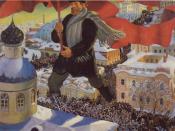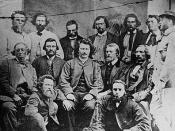What if czars still ruled Russia? 1914 marked the beginning of the time, in Russia, known as the Russian Revolution. The country saw many changes especially political and economical changes. It saw the fall of the Romanov Dynasty, the rise and fall of the Provisional Government, and the rise of the Bolsheviks, who later became the Communists that ran the Soviet Union for more than half a century. Present day historians view the Russian Revolution as the definitive moment in Russian history. The Russian Revolution brought many changes to the Russian society that helped to bring it up as a world power.
Czar Nicholas II greatly hurt the Russian society during his final years as czar. Hunger plagued the Russian society. There was also a breakdown of communication between the citizens and the government. Demographic losses also affected the population. (Lewin, 48) All of these problems can be linked to Czar Nicholas II.
Petrograd (St. Petersburg) and Moscow were important cities for the Bolsheviks during the revolution. Both cities suffered great social and economical problems. "In 1917 the two cities had a combined population of four million inhabitants. In 1920 only 1,674,000 remained. Almost the entire industrial work force of Petrograd was lost through migration, mobilization, and death." (Lewin, 48) The population of larger developed cities suffered great population declinations. Less industrialized cities didn't suffer nearly as much. Some of the less industrialized cities even grew. Parts of the large-scale industry that didn't stop completely diminished exorbitantly. The national industrial labor force was cut in half. (Lewin, 49) "The term deindustrialization is fully legitimate here." (Lewin, 49) All of these problems merely set the stage for the beginning of the revolutions.
The February Revolution was the first of the revolutions. After Czar Nicholas II abdicated the entire monarchy fell.


![Image taken from page 125 of 'The Provisional Government of Nebraska Territory and the Journals of William Walker, Provisional Governor of Nebraska Territory. Edited by William E. Connelley, etc. [With portraits and a map.]'](https://s.writework.com/uploads/13/137973/image-taken-page-125-provisional-government-nebraska-territo-thumb.jpg)